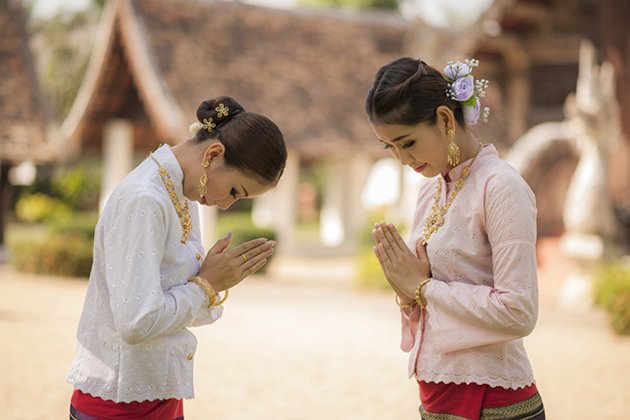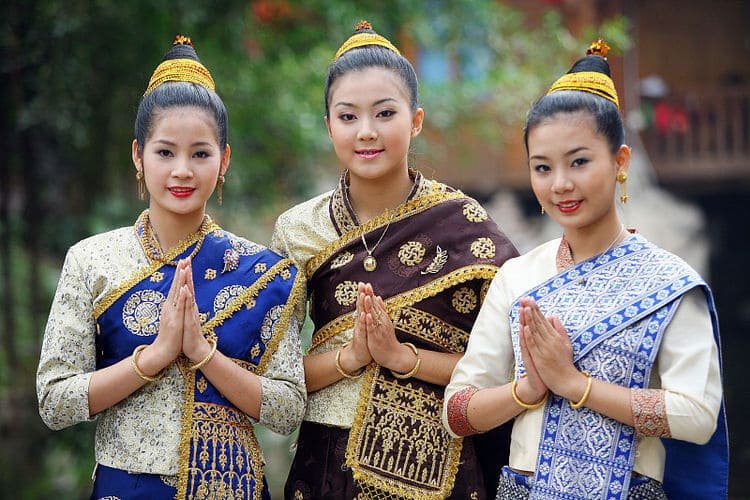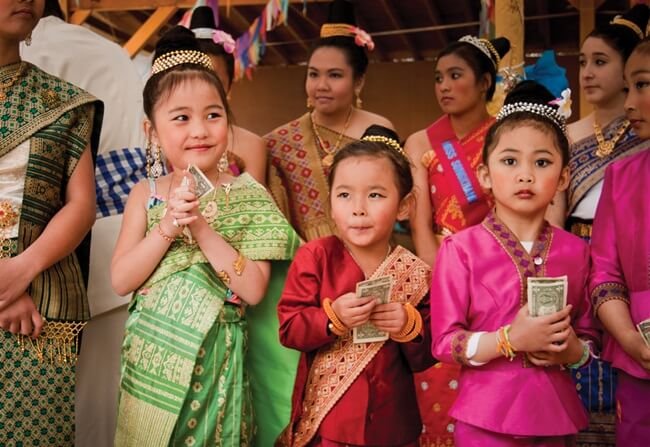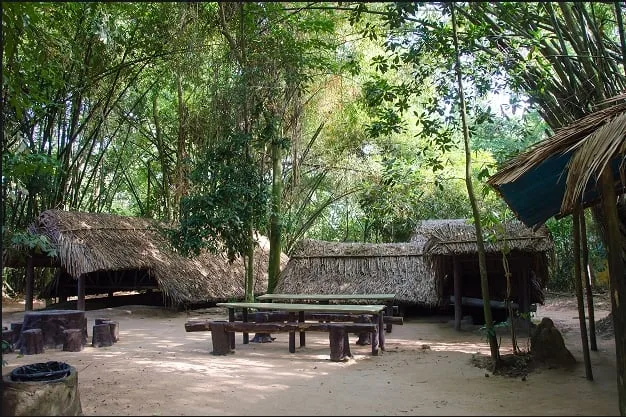Contents
ToggleHow to Say “Hello” in Lao
The universal greeting:
- Sabaï dii (ສະບາຍດີ) — Hello
Use it any time of day with a smile. Here are a few situational greetings:
- Good morning – Sabaï dii ton sao
- Good afternoon – Sabaï dii ton suaai
- Good evening / night – Non lap fan dii
- Sweet dreams – Nai ton kham khun thidi

The “Nop” Gesture: Greeting with Respect
The traditional Lao greeting involves:
- Pressing your palms together
- Slightly bowing your head
🤝 Nop Etiquette
| Situation | Hand Position | Bow Depth |
| Greeting a peer | Chin level | Light bow |
| Greeting someone older | Nose level | Medium bow |
| Greeting a monk or elder | Forehead level | Deep bow |
| Worship at temples/statues | Kneeling | Forehead to floor |
The younger or lower-status person initiates the nop.
👤 Gender & Social Greeting Norms
- Men ↔ Men: Light bow, no touch
- Women: Always use the nop; avoid shaking hands
- Opposite genders: Avoid physical contact unless close or in formal settings
🗣️ Using Honorifics in Lao
Show politeness by using titles:
| Relation | Lao Title |
| Grandfather | Pho Thao |
| Grandmother | Mae Thao |
| Uncle | Lung |
| Aunt | Na Sao |
| Older brother | Aiy |
| Older sister | Ueay |
Use Than (men) or Than Nang (women) for formal respect.
🌏 Modern Greetings in Laos
- In cities like Vientiane or Luang Prabang, handshakes and English greetings are more common among younger locals.
- Traditional greetings remain important—especially in rural and religious settings.
🌐 Languages Spoken in Laos
- Lao: Official and most widely used
- Thai: Understood due to cultural and linguistic overlap
- English: Common in tourism, hotels, and among youth
- French: Still used in government, schools, and older generations

Essential Lao Phrases for Travelers
🧑🤝🧑 Basic Conversation
| English | Lao |
| Hello | Sabaï dii |
| How are you? | Sabaï dii bò? |
| I’m fine | Khòy sabaï dii, khop jai |
| Thank you | Khop jai |
| You’re welcome | Bò pen nyang |
| Goodbye | Sòhk dii deu |
| Please | Khaluna |
| Sorry | Khǎw thôt |
🛍️ Shopping & Bargaining
| English | Lao |
| How much is it? | Lá-khá thao dai? |
| That’s expensive! | Péng pôt! |
| It’s cheap | Bò peng |
| I want to buy this | Khòy yàk sèu an ni |
| Lower the price? | Lòt lá-khá dai bò? |
🚗 Transport & Directions
| English | Lao |
| I want to go to… | Khòy yàk pai… |
| Where is…? | …yùu sai? |
| I’m lost | Khòy long thang |
| Bus / Train | Lot mé / Kan fakop hom |
| Bicycle / Boat | Lot thiip / Heu |
🧭 Numbers
| English | Lao |
| One | Neung |
| Two | Song |
| Three | Sam |
| Four | Si |
| Five | Ha |
| Ten | Sip |
🍽️ At the Table
| English | Lao |
| I’m hungry | Khòy hǐw |
| Water / Beer | Nám / Bia |
| I want to eat this | Khòy yàk kin an ni |
| Cheers! | Nok nok! |
| Delicious | Sèp lai |
| The bill, please | Check bin, khaluna |
🚨 Health & Safety
| English | Lao |
| I don’t feel well | Khòy bò sabaï |
| Help! | Sùai! |
| Call a doctor | Ot-tha-than mo! |
| Hospital | Hòng mo |
| Police | Tam lùat |

Final Thoughts
Laos is a country of grace, kindness, and deep-rooted traditions. While English may get you by in tourist areas, learning a few Lao phrases—and mastering the nop greeting—can elevate your trip from good to unforgettable.
A simple “Sabaï dii” with a heartfelt smile is often all it takes to make a connection. Show curiosity and respect, and you’ll find Lao people ready to return the kindness tenfold.
🧡 Laos isn’t just a destination—it’s a chance to slow down, connect, and be present. Let your words and gestures reflect that.





















